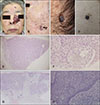This article has been
cited by other articles in ScienceCentral.
Dear Editor:
Multiple basal cell carcinomas (BCCs) have genetic backgrounds as nevoid basal cell carcinoma syndrome (NBCCS), although multiple BCCs with unknown genetic backgrounds exist
1234. Furthermore, cases of multiple BCCs with infundibular structures and trichoblastoma are quite limited
25. Here we present a novel case of multiple BCCs with trichoblastoma.
An 82-year-old female presented with a painful ulcerated black tumor on her left cheek. A black nodule on her left cheek had been recognized in 2010. She had no familial history of NBCCS. A physical examination revealed a 43×40 mm ulcerated black tumor mass on her left cheek (
Fig. 1A). The patient also had seven 2 to 10 mm black nodules on her face and neck and two 3.5×3 mm nodules on her back (
Fig. 1B~D). Histopathological examination of the tumor on her face showed tumor nests in conjunction with the epidermis. The tumor nests manifested infiltrative proliferative patterns (
Fig. 1E). Each tumor nest was composed of basaloid cells. Some tumor nests were arranged in an anastomosing fashion (
Fig. 1F). Immunohistochemistry revealed positive reactions for cytokeratin 14 (CK14), CK17, Ber-EP4 and Bcl-2 and negative reactions for CK20 and CD34. The diagnosis of BCC was made. Histopathology of the tumor on her cheek showed large tumor nests that extend into the deep dermis (
Fig. 1G). Each tumor nest showed a palisading arrangement (
Fig. 1H). Physical examination revealed a 5×4 mm black nodule adjacent to the tumor mass (
Fig. 2A). Histopathological examinations showed that anastomosing tumor nests extended into the deep dermis (
Fig. 2B). Infundibular structures were situated in the center of the tumor (
Fig. 2C).
Immunohistochemistry revealed almost consistent results with the tumor mass. We considered this nodule as BCC with infundibular structures. A physical examination revealed a 15×15 mm subcutaneous tumor on her left buttock (
Fig. 2D). Histopathological examinations showed a well-circumscribed tumor with a surrounding cleft. No continuity between the epidermis and the tumor was found (
Fig. 2E). Some of tumor nests showing a differentiation toward follicular structures (
Fig. 2F). We considered this nodule as a trichoblastoma. We performed radiation with 60 Gy of the tumor mass on her left cheek.
Multiple BCCs include various expressions with benign and/or malignant neoplasms with follicular differentiation and some of them have been classified as hereditary diseases such as NBCCS
12. The exact clinical entity and the etiology of various multiple BCCs have not been fully elucidated due to the limited number of cases. Our case was difficult to assign into an existing clinical and histopathological entity. However, multiple occurrences of both benign and malignant follicular neoplasms may imply shared genetic aberrations. Our case of multiple BCCs is also extremely valuable in terms of the association with trichoblastoma. Although an association of trichoblastoma with multiple BCC is rare, various expressions of follicular neoplasms from benign neoplasm to malignant neoplasms in our case may account for the occurrence of trichoblastoma in a case with multiple BCC. Accumulation of such cases should be important for the elucidation of multiple BCC.
Figures and Tables
Fig. 1
(A) An ulcerated black tumor mass on her face. (B) A keratotic black nodule on her left cheek; the arrow indicates the lesion. (C) A black nodule on her neck. (D) A black nodule on her back. (E) Histopathology of the tumor on her face showing tumor nests extending to the subcutaneous tissue (H&E, ×40). (F) Some tumor nests arranged in an anastomosing fashion (H&E, ×200). (G) Histopathology of the tumor on her cheek showing large tumor nests that extend into the deep dermis (H&E, ×40). (H) Each tumor nest showing a palisading arrangement (H&E, ×100). We received the patient's consent form about publishing all photographic materials.

Fig. 2
(A) A nodule adjacent to the tumor mass on her left cheek; the arrow indicates the lesion. (B) Histopathology showing anastomosing tumor nests extending into the deep dermis in conjunction to the epidermis (H&E, ×40). (C) Infundibular structures situated in the center of the tumor (H&E, ×100). (D) A subcutaneous tumor on her left buttock. (E) Histopathology showing a well-circumscribed tumor with a surrounding cleft in the deep dermis. No continuity of the epidermis and the tumor was found (H&E, ×20). (F) Some of tumor nests showing a differentiation toward follicular structures (H&E, ×400).







 PDF
PDF ePub
ePub Citation
Citation Print
Print



 XML Download
XML Download